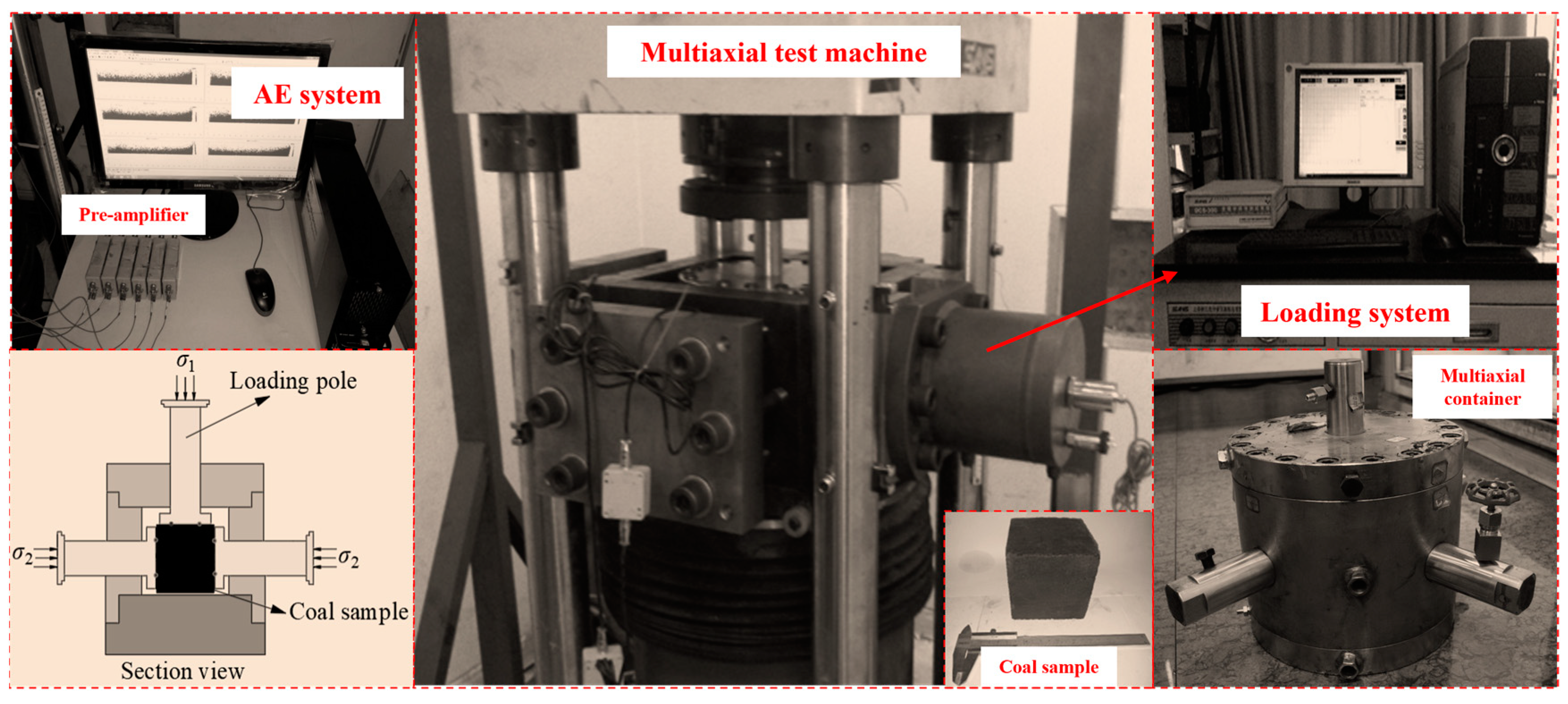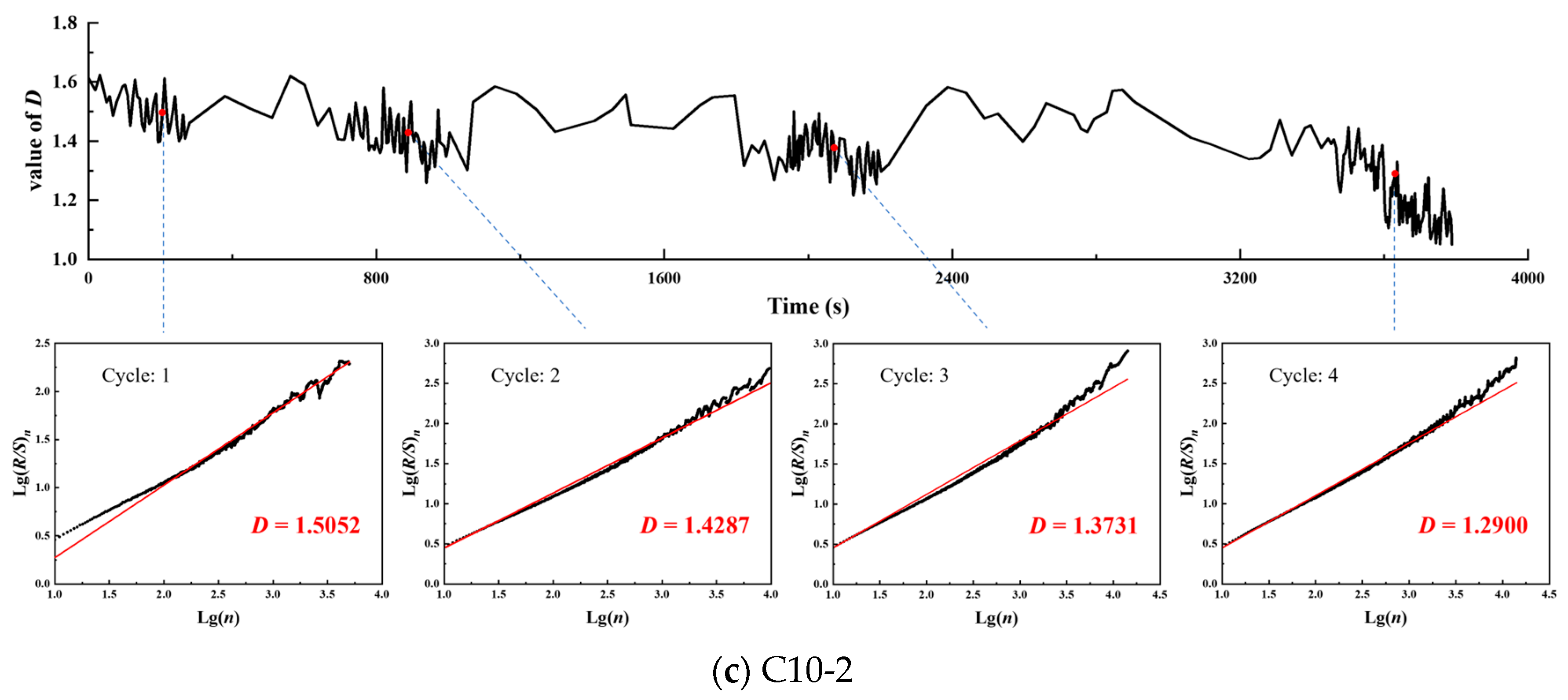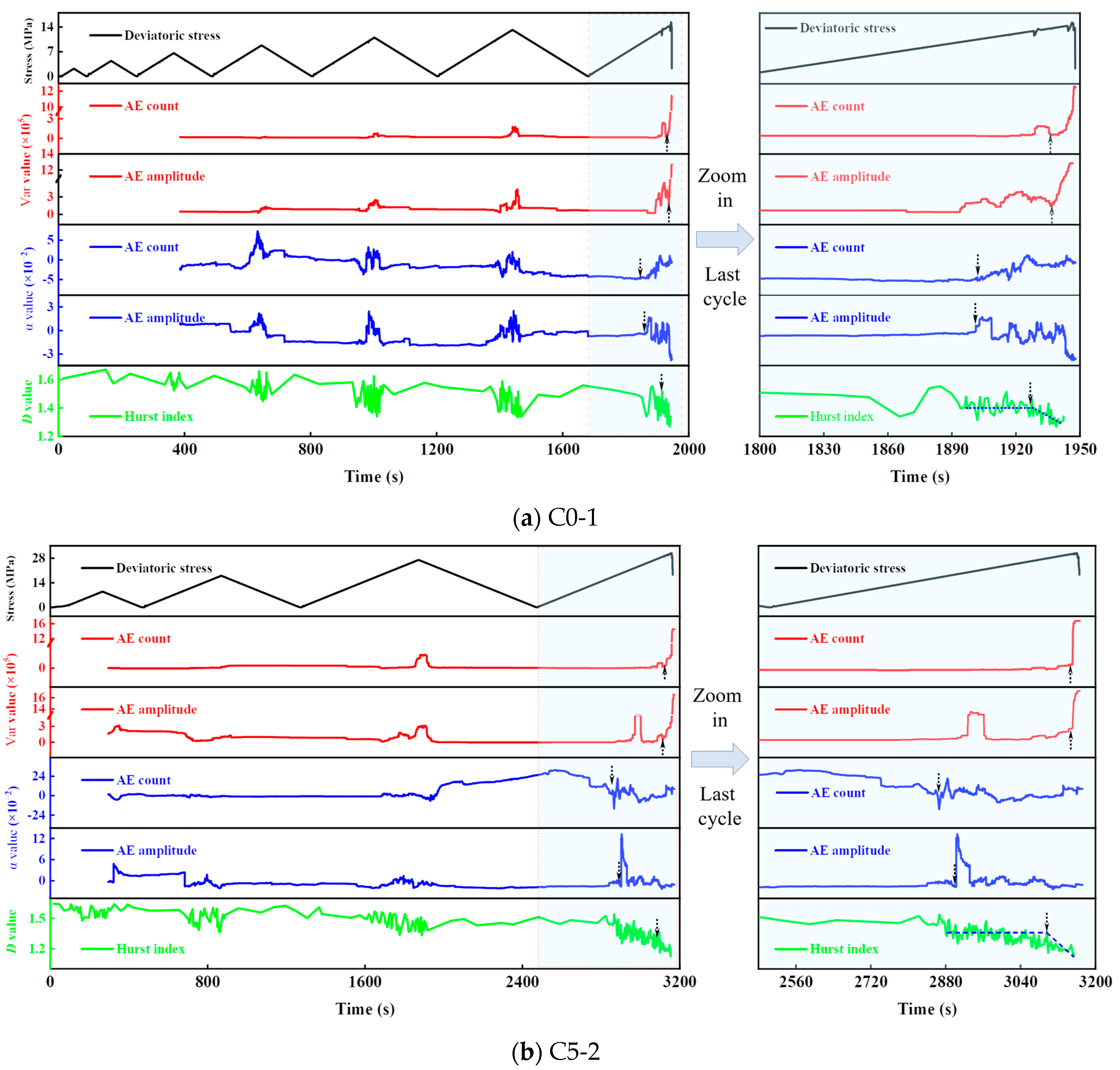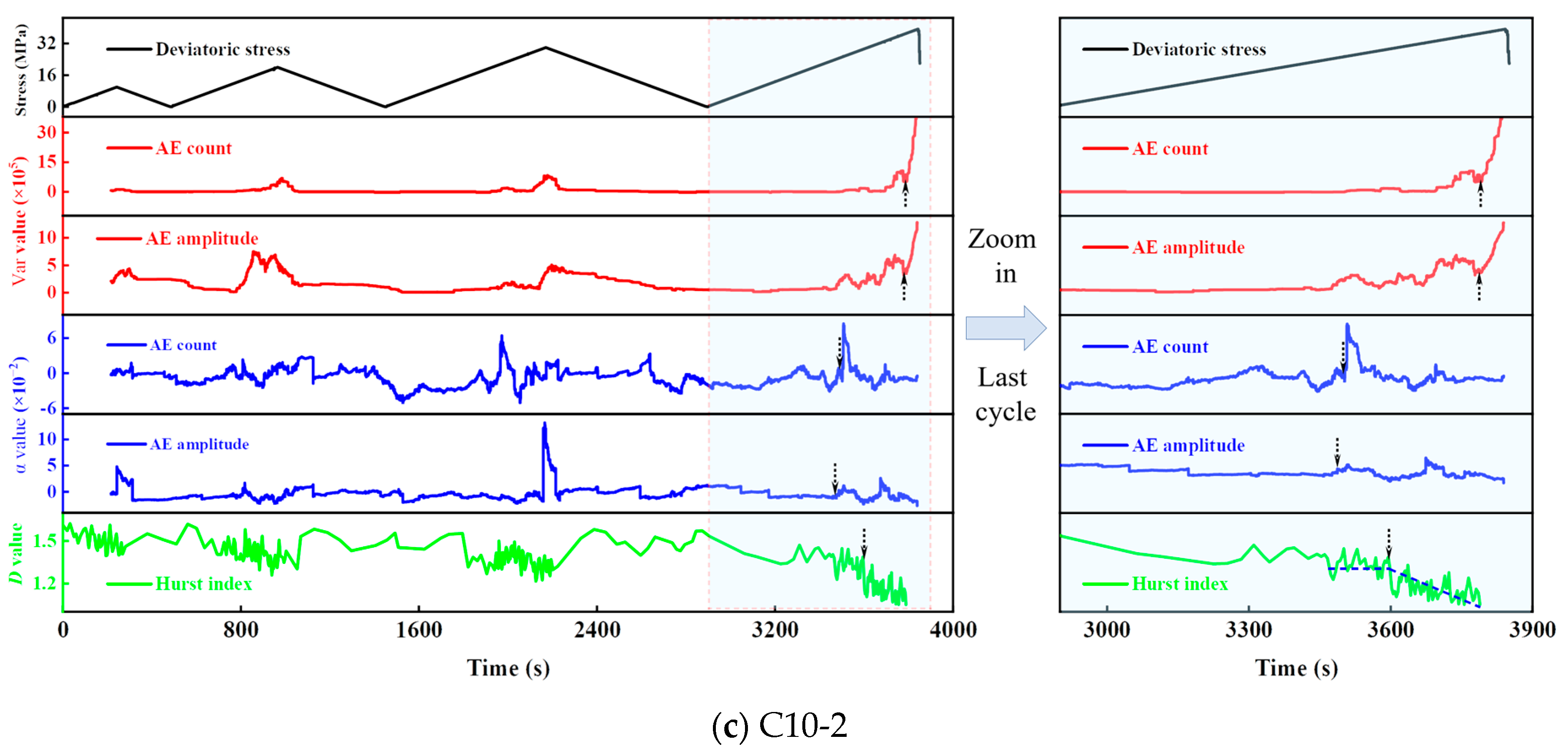Mechanical Behaviors and Precursory Characteristics of Coal-Burst in Deep Coal Mining for Safety-Sustainable Operations: Insights from Experimental Analysis
Abstract
:1. Introduction
2. Experimental System, Material and Scheme
2.1. Experimental System
2.2. Coal Sample Preparation and Properties
2.3. Test Scheme and Procedure
3. Mechanical and Energy Evolution of Coal under Mining Cyclic Loads
3.1. Mechanical Properties
3.2. Energy Evolution Characteristics
4. AE Varying Characteristics of Coal under Multiaxial Cyclic Loads
4.1. Evolution of AE Characteristic Parameters
4.2. Shear-Tensile Property of Microcracks Judged by AE
4.3. RS Fractal Features of AE Signals
5. Discussion
5.1. Confining Pressure Effects on Coal Mechanical and AE Parameters
5.2. AE Multi-Parameter Precursor Response
6. Conclusions
Author Contributions
Funding
Institutional Review Board Statement
Informed Consent Statement
Data Availability Statement
Conflicts of Interest
References
- Bukowska, M. Post-Critical Mechanical Properties of Sedimentary Rocks in the Upper Silesian Coal Basin (Poland). Arch. Min. Sci. 2015, 60, 517–534. [Google Scholar] [CrossRef]
- Wu, L.; Wang, Z.; Ma, D.; Zhang, J.; Wu, G.; Wen, S.; Zha, Z.; Wu, L. A Continuous Damage Statistical Constitutive Model for Sandstone and Mudstone Based on Triaxial Compression Tests. Rock Mech. Rock Eng. 2022, 55, 4963–4978. [Google Scholar] [CrossRef]
- Chen, X.; Li, L.; Wang, L. The Mechanical Effect of Typical Dynamic Disaster Evolution and Occurrence in Coal Mines. Energy Sources Part A Recovery Util. Environ. Eff. 2022, 44, 2839–2850. [Google Scholar] [CrossRef]
- Zhou, B.; Xu, J.; Peng, S.; Yan, F.; Gao, Y.; Li, Q.; Cheng, L. Effects of Geo-Stress on the Dynamic Response of Multi-Physical Field Parameters during Coal and Gas Outbursts under True Triaxial Stress. Int. J. Rock Mech. Min. Sci. 2021, 142, 104759. [Google Scholar] [CrossRef]
- Wang, H.; Li, J. Mechanical Behavior Evolution and Damage Characterization of Coal under Different Cyclic Engineering Loading. Geofluids 2020, 2020, e8812188. [Google Scholar] [CrossRef]
- Chen, Y.; Lu, A.; Mao, X.; Li, M.; Zhang, L. Nonlinear Dynamics Mechanism of Rock Burst Induced by the Instability of the Layer-Crack Plate Structure in the Coal Wall in Deep Coal Mining. Shock Vib. 2017, 2017, e4051967. [Google Scholar] [CrossRef]
- Pan, Y.; Song, Y.; Liu, J. Pattern, change and New Situation of Coal Mine Rockburst Prevention and Control in China. Yanshilixue Yu Gongcheng Xuebao/Chin. J. Rock Mech. Eng. 2023, 42, 2081–2095. [Google Scholar] [CrossRef]
- Zhang, Y.; Yang, Y.; Ma, D. Mechanical Characteristics of Coal Samples under Triaxial Unloading Pressure with Different Test Paths. Shock Vib. 2020, 2020, e8870821. [Google Scholar] [CrossRef]
- Li, X.; Li, H.; Yang, Z.; Sun, Z.; Zhuang, J.; Song, C.; Wang, X. Experimental Study on Triaxial Unloading Failure of Deep Composite Coal-Rock. Adv. Civ. Eng. 2021, 2021, e6687051. [Google Scholar] [CrossRef]
- Zhou, X.; Liu, X.; Wang, X.; Xie, H.; Du, P. Failure Characteristics and Mechanism of Coal under the Coupling between Different Confining Pressures and Disturbance Loading. Bull. Eng. Geol. Environ. 2023, 82, 442. [Google Scholar] [CrossRef]
- Li, T.; Yue, Z.; Li, J.; Chen, G.; Li, Q.; Lu, Y. Effect of Confining Pressure Strength on the Characteristics of Energy Evolution and Fatigue Fracture of the Coal-Rock Structural Body. Fatigue Fract. Mater. Struct. 2024, 47, 709–727. [Google Scholar] [CrossRef]
- Du, X.; Xue, J.; Shi, Y.; Cao, C.-R.; Shu, C.-M.; Li, K.; Ma, Q.; Zhan, K.; Chen, Z.; Wang, S. Triaxial Mechanical Behaviour and Energy Conversion Characteristics of Deep Coal Bodies under Confining Pressure. Energy 2023, 266, 126443. [Google Scholar] [CrossRef]
- Duan, M.; Jiang, C.; Yin, W.; Yang, K.; Li, J.; Liu, Q. Experimental Study on Mechanical and Damage Characteristics of Coal under True Triaxial Cyclic Disturbance. Eng. Geol. 2021, 295. [Google Scholar] [CrossRef]
- Shkuratnik, V.L.; Filimonov, Y.L.; Kuchurin, S.V. Regularities of Acoustic Emission in Coal Samples under Triaxial Compression. J. Min. Sci. 2005, 41, 44–52. [Google Scholar] [CrossRef]
- Wang, X.; Wang, E.; Liu, X.; Zhou, X. Micromechanisms of Coal Fracture: Insights from Quantitative AE Technique. Theor. Appl. Fract. Mech. 2021, 114, 103000. [Google Scholar] [CrossRef]
- Wu, L.; Ma, D.; Wang, Z.; Zhang, J.; Zhang, B.; Li, J.; Liao, J.; Tong, J. A Deep CNN-Based Constitutive Model for Describing of Statics Characteristics of Rock Materials. Eng. Fract. Mech. 2023, 279, 109054. [Google Scholar] [CrossRef]
- Li, D.; Wang, E.; Kong, X.; Wang, X.; Zhang, C.; Jia, H.; Wang, H.; Qian, J. Fractal Characteristics of Acoustic Emissions from Coal under Multi-Stage True-Triaxial Compression. J. Geophys. Eng. 2018, 15, 2021–2032. [Google Scholar] [CrossRef]
- Kong, X.; Zhan, M.; Cai, Y.; Ji, P.; He, D.; Zhao, T.; Hu, J.; Lin, X. Precursor Signal Identification and Acoustic Emission Characteristics of Coal Fracture Process Subjected to Uniaxial Loading. Sustainability 2023, 15, 11581. [Google Scholar] [CrossRef]
- Zhou, X.; Liu, X.; Wang, X.; Liu, Y.; Xie, H.; Du, P. Acoustic Emission Characteristics of Coal Failure Under Triaxial Loading and Unloading Disturbance. Rock Mech. Rock Eng. 2023, 56, 1043–1061. [Google Scholar] [CrossRef]
- Wang, M.; Zhang, J.; Jia, B.; Du, W.; Chen, Z.; Liu, S. Research on Prediction of Coal Sample Deformation Based on Acoustic-Emission Sensitive Index. Sustainability 2022, 14, 14875. [Google Scholar] [CrossRef]
- Shan, P.; Li, W.; Lai, X.; Zhang, S.; Chen, X.; Wu, X. Research on the Response Mechanism of Coal Rock Mass under Stress and Pressure. Materials 2023, 16, 3235. [Google Scholar] [CrossRef] [PubMed]
- Yang, Y.; Zhang, Y.; Zhang, T. The Establishment of Segmented Constitutive Relationship of Coal under Triaxial Compression: Take the No. 3 Coal of Xinhe Colliery as an Example. Adv. Civ. Eng. 2020, 2020, e8861936. [Google Scholar] [CrossRef]
- Wang, X.; Zhao, Y.; Gao, Y.; Sun, Z.; Liu, B.; Jiang, Y. Energy Evolution of Anthracite Considering Anisotropy Under High Confining Pressure: An Experimental Investigation. Rock Mech. Rock Eng. 2023, 56, 6735–6759. [Google Scholar] [CrossRef]
- Gong, F.; Wang, Y. A New Rock Brittleness Index Based on the Peak Elastic Strain Energy Consumption Ratio. Rock Mech. Rock Eng. 2022, 55, 1571–1582. [Google Scholar] [CrossRef]
- Gao, D.; Sang, S.; Liu, S.; Wu, J.; Geng, J.; Tao, W.; Sun, T. Experimental Study on the Deformation Behaviour, Energy Evolution Law and Failure Mechanism of Tectonic Coal Subjected to Cyclic Loads. Int. J. Min. Sci. Technol. 2022, 32, 1301–1313. [Google Scholar] [CrossRef]
- Duan, H.; Ma, D. Acoustic Emission Simulation on Coal Specimen Subjected to Cyclic Loading. Adv. Civ. Eng. 2020, 2020, e3798292. [Google Scholar] [CrossRef]
- Moradian, Z.; Einstein, H.H.; Ballivy, G. Detection of Cracking Levels in Brittle Rocks by Parametric Analysis of the Acoustic Emission Signals. Rock Mech. Rock Eng. 2016, 49, 785–800. [Google Scholar] [CrossRef]
- Shkuratnik, V.L.; Filimonov, Y.L.; Kuchurin, S.V. Features of the Kaiser Effect in Coal Specimens at Different Stages of the Triaxial Axisymmetric Deformation. J. Min. Sci. 2007, 43, 1–7. [Google Scholar] [CrossRef]
- Sellers, E.J.; Kataka, M.O.; Linzer, L.M. Source Parameters of Acoustic Emission Events and Scaling with Mining-Induced Seismicity. J. Geophys. Res. Solid Earth 2003, 108. [Google Scholar] [CrossRef]
- Zhang, A.; Feng, T.; Jiang, L.; Wang, D.; Wang, Z.; Zhang, R.; Feng, G.; Zhang, Z.; Deng, J.; Ren, L. Energy Characteristics and Micro-Cracking Behaviors of Deep Slate Rock under Triaxial Loadings. Acta Geophys. 2022, 70, 1457–1472. [Google Scholar] [CrossRef]
- Ju, S.; Li, D.; Jia, J. Machine-learning-based Methods for Crack Classification Using Acoustic Emission Technique. Mech. Syst. Signal Process. 2022, 178, 109253. [Google Scholar] [CrossRef]
- He, M.C.; Miao, J.L.; Feng, J.L. Rock Burst Process of Limestone and Its Acoustic Emission Characteristics under True-Triaxial Unloading Conditions. Int. J. Rock Mech. Min. Sci. 2010, 47, 286–298. [Google Scholar] [CrossRef]
- Petružálek, M.; Jechumtálová, Z.; Šílený, J.; Kolář, P.; Svitek, T.; Lokajíček, T.; Turková, I.; Kotrlý, M.; Onysko, R. Application of the Shear-Tensile Source Model to Acoustic Emissions in Westerly Granite. Int. J. Rock Mech. Min. Sci. 2020, 128, 104246. [Google Scholar] [CrossRef]
- Rodríguez, P.; Celestino, T.B. Application of Acoustic Emission Monitoring and Signal Analysis to the Qualitative and Quantitative Characterization of the Fracturing Process in Rocks. Eng. Fract. Mech. 2019, 210, 54–69. [Google Scholar] [CrossRef]
- Ohtsu, M. Quantitative AE Techniques Standardized for Concrete Structures. Adv. Mater. Res. 2006, 13–14, 183–192. [Google Scholar] [CrossRef]
- Ma, T.; Ma, D.; Yang, Y. Fractal Characteristics of Coal and Sandstone Failure under Different Unloading Confining Pressure Tests. Adv. Mater. Sci. Eng. 2020, 2020, e2185492. [Google Scholar] [CrossRef]
- Kong, X.; Wang, E.; Hu, S.; Shen, R.; Li, X.; Zhan, T. Fractal Characteristics and Acoustic Emission of Coal Containing Methane in Triaxial Compression Failure. J. Appl. Geophys. 2016, 124, 139–147. [Google Scholar] [CrossRef]
- Biancolini, M.E.; Brutti, C.; Paparo, G.; Zanini, A. Fatigue Cracks Nucleation on Steel, Acoustic Emission and Fractal Analysis. Int. J. Fatigue 2006, 28, 1820–1825. [Google Scholar] [CrossRef]
- Zhang, E.; Zhou, B.; Li, P. Comparative Research on the Precursory Characteristics of Critical Slowing down before the Failure of Raw Coal and Briquettes. Bull. Eng. Geol. Environ. 2023, 82, 358. [Google Scholar] [CrossRef]
- Hao, T.; Li, F.; Tang, Y.; Zhao, L.; Wang, Z. Infrared Precursor of Pre-Cracked Coal Failure Based on Critical Slowing Down. Geomat. Nat. Hazards Risk 2022, 13, 1682–1699. [Google Scholar] [CrossRef]
- Liu, Y.; Yin, G.; Li, M.; Zhang, D.; Huang, G.; Liu, P.; Liu, C.; Zhao, H.; Yu, B. Mechanical Properties and Failure Behavior of Dry and Water-Saturated Anisotropic Coal Under True-Triaxial Loading Conditions. Rock Mech. Rock Eng. 2020, 53, 4799–4818. [Google Scholar] [CrossRef]















| Sample ID | Density (g/cm3) | P-Wave Velocity (m/s) | S-Wave Velocity (m/s) | Elastic Modulus (GPa) | Poisson’s Ratio |
|---|---|---|---|---|---|
| C0-1 | 1.29 | 1377 | 742 | 1.79 | 0.297 |
| C0-2 | 1.29 | 1389 | 745 | 1.83 | 0.292 |
| C0-3 | 1.30 | 1385 | 743 | 1.89 | 0.297 |
| C5-1 | 1.30 | 1382 | 748 | 1.84 | 0.298 |
| C5-2 | 1.31 | 1379 | 749 | 1.87 | 0.296 |
| C5-3 | 1.29 | 1390 | 742 | 1.85 | 0.293 |
| C10-1 | 1.29 | 1379 | 745 | 1.92 | 0.295 |
| C10-2 | 1.31 | 1378 | 747 | 1.89 | 0.297 |
| C10-3 | 1.32 | 1388 | 744 | 1.86 | 0.289 |
| Confining Pressure | Cycles | Residual Deformation (%) | Reversible Energy (J) | Irreversible Energy (J) | Input Energy (J) | Felicity Ratio | D Value |
|---|---|---|---|---|---|---|---|
| 0 MPa | 1 | 0.31 | 6.52 | 1.99 | 8.51 | / | 1.613 |
| 2 | 0.33 | 16.23 | 3.55 | 19.78 | 1.532 | ||
| 3 | 0.38 | 26.96 | 5.79 | 32.75 | 1.203 | 1.554 | |
| 4 | 0.44 | 38.03 | 8.54 | 46.57 | 1.023 | ||
| 5 | 0.57 | 51.75 | 19.28 | 71.03 | 0.953 | 1.455 | |
| 6 | 0.68 | 66.94 | 22.10 | 89.04 | 0.825 | ||
| 7 | / | 10.07 | 210.18 | 250.85 | 0.715 | 1.397 | |
| 5 MPa | 1 | 0.49 | 34.64 | 15.14 | 49.78 | / | 1.578 |
| 2 | 1.52 | 160.01 | 65.27 | 225.27 | 1.060 | 1.510 | |
| 3 | 2.08 | 192.87 | 157.73 | 350.60 | 0.894 | 1.456 | |
| 4 | / | 111.03 | 1052.9 | 1163.93 | 0.722 | 1.329 | |
| 10 MPa | 1 | 0.49 | 55.00 | 22.30 | 77.30 | / | 1.505 |
| 2 | 1.91 | 251.97 | 83.04 | 335.01 | 1.102 | 1.429 | |
| 3 | 2.70 | 315.10 | 230.13 | 545.23 | 0.944 | 1.373 | |
| 4 | / | 178.36 | 1412.13 | 1590.49 | 0.781 | 1.290 |
Disclaimer/Publisher’s Note: The statements, opinions and data contained in all publications are solely those of the individual author(s) and contributor(s) and not of MDPI and/or the editor(s). MDPI and/or the editor(s) disclaim responsibility for any injury to people or property resulting from any ideas, methods, instructions or products referred to in the content. |
© 2024 by the authors. Licensee MDPI, Basel, Switzerland. This article is an open access article distributed under the terms and conditions of the Creative Commons Attribution (CC BY) license (https://creativecommons.org/licenses/by/4.0/).
Share and Cite
Wang, X.; Wang, J.; Zhou, X.; Liu, X.; Liu, S. Mechanical Behaviors and Precursory Characteristics of Coal-Burst in Deep Coal Mining for Safety-Sustainable Operations: Insights from Experimental Analysis. Sustainability 2024, 16, 2103. https://doi.org/10.3390/su16052103
Wang X, Wang J, Zhou X, Liu X, Liu S. Mechanical Behaviors and Precursory Characteristics of Coal-Burst in Deep Coal Mining for Safety-Sustainable Operations: Insights from Experimental Analysis. Sustainability. 2024; 16(5):2103. https://doi.org/10.3390/su16052103
Chicago/Turabian StyleWang, Xiaoran, Jinhua Wang, Xin Zhou, Xiaofei Liu, and Shuxin Liu. 2024. "Mechanical Behaviors and Precursory Characteristics of Coal-Burst in Deep Coal Mining for Safety-Sustainable Operations: Insights from Experimental Analysis" Sustainability 16, no. 5: 2103. https://doi.org/10.3390/su16052103





